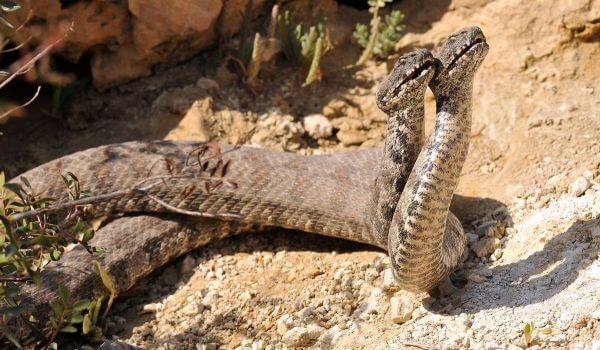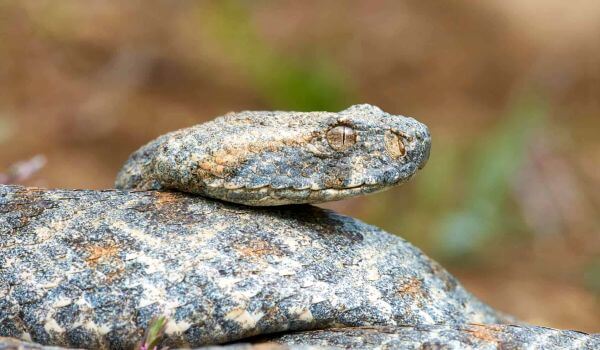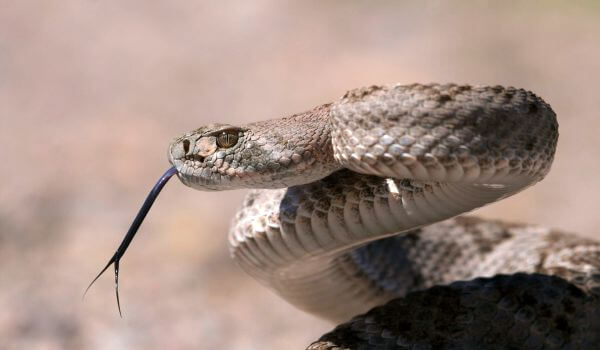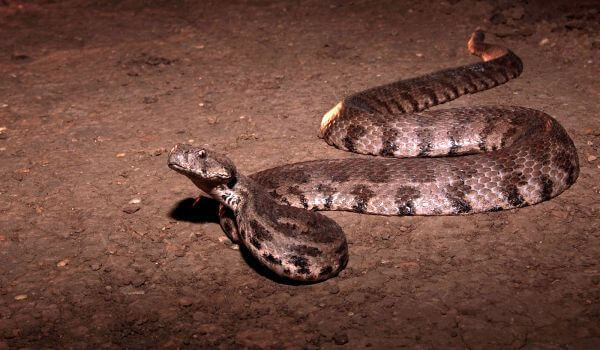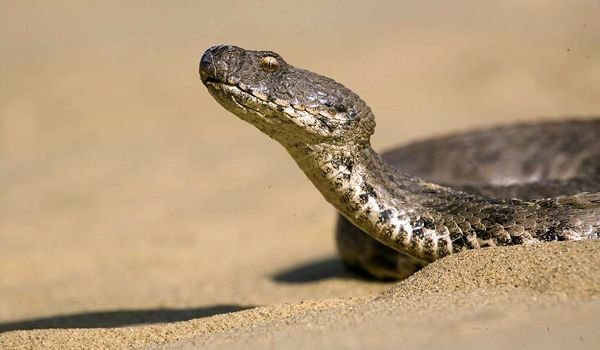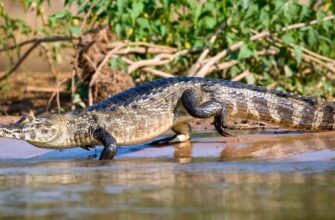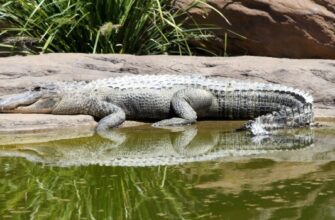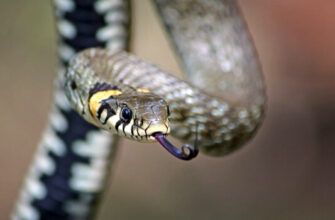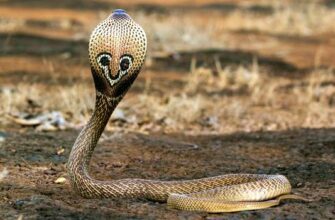Gyurza is one of the most dangerous and insidious snakes, the poison of which is second only to that of the cobra, it belongs to the viper family, it is very large-sized, because it is related to the genus of giant vipers. Let’s try to analyze in detail her appearance, habits, character, to find out if she is really as insidious and formidable as they say she is?
Origin of the species and description
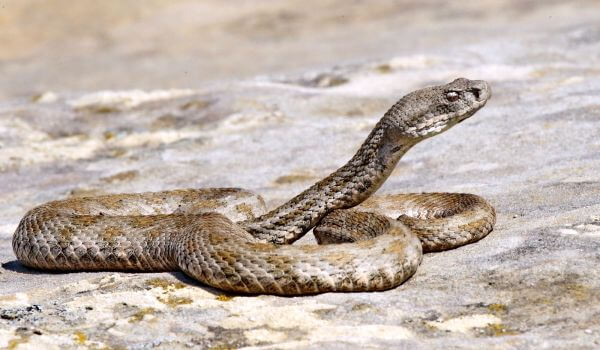
Photo: Gyurza
Gyurza is the most dangerous, poisonous snake, the largest representative of the viper family. Gyurza has many names and nicknames, it is often called the Levant viper. The very word “gyurza” comes from the Persian language and in translation from it means “mace” or “iron club”. This name is rooted behind the snake, thanks to its powerful muscular body, similar to a real club.
From Latin, the name of the snake is translated as “coffin viper.” The Uzbek people call it a green snake, and the Turkmen people call it a horse. No matter how and where it is called, one thing is absolutely clear – it is very dangerous, poisonous and has an impressive size.
Video: Gyurza
On the territory of the former Soviet Union, this is the most dangerous and largest snake, all its viper relatives are poisonous, but the viper is the most poisonous of them, it is recognized as such not only in our country and the former countries of the USSR, but throughout the world. Now herpetologists distinguish 6 subspecies of this dangerous reptile, but one of them remains in doubt. All varieties differ not only in their habitat, but also in size, some external features.
Describing the gyurza, it can be noted that it is of very large dimensions, which can reach a length (together with the tail section) up to 2 m, and weigh about 3 kg. The body of the gyurza is strong and powerful, its thickness in girth can be more than a human hand. The skin color of different subspecies is different, it all depends on the permanent habitat of the snake.
The venom of the viper is so dangerous and strong that it has almost the same strength as that of the Asian cobra. Getting into the human blood, the poison begins to destroy its red blood cells. And any delay is fatal.
An interesting fact: about 15 percent of all viper bites are fatal if not treated. As an antidote, doctors inject a special serum into the body, each time warning that self-treatment must be excluded, because it can be fatal. several thousand people, so you need to know what kind of appearance a coffin viper has in order not to become its victim.
Appearance and features
Photo: Gyurza snake
Despite the fact that there are specimens of snakes reaching two meters in length, the average body length of a gyurza is a little less than one and a half meters. The head of the gyurza has the shape of a triangle, and the whole body is very powerful, muscular. Small scales are visible above the eyes of the gyurza, this distinguishes it from its relatives. Other godyukovs have small shields on their heads, while the gyurza has rough scales covering its head. The pupil of the reptile is located vertically, and the muzzle is slightly rounded.
The color of the snake head is monochromatic, there is no pattern on it. The color scheme of the whole body can be different, it depends on the species and the places where the snake lives.
The general tone of the skin can be:
- Light gray;
- Reddish brown;
- Brown;
- Grey-beige;
- Dark gray;
- Black (sometimes with blue).
The pattern on the skin of the body differs between subspecies, but usually these are darker spots that are located on the back and sides. These spots have a brown tint with a touch of some rust, they are much smaller on the sides of the snake than along the ridge.
The belly of the snake is always a lighter shade, which also has a spotted ornament. It should be noted that the spots that adorn the body of the snake are not very contrasting, therefore the pattern on the skin is not so bright. Not all Levantine vipers are decorated with a pattern, there are snakes of a solid color, often they are brown and even black.
Where does the gyurza live?
Photo: Gyurza Animal
The distribution area of u200bu200bgyurza is very wide. The snake lives in such countries of North Africa as Tunisia, Morocco and Algeria. The Levantine viper also settled on some islands in the Aegean Sea. Gyurza lives in the east of Asia Minor, in Syria, Palestine, Iraq, Jordan, Iran, Arabia. The republics of Transcaucasia act as the place of permanent residence of the reptile, the exception is Abkhazia, you will not find gyurza there.
The snake also took a fancy to Central Asia, Afghanistan, northwest India. Transcaucasian Gyurza lives in our country. She settled in the southeastern part of Dagestan, she is listed in the Red Book of Russia. A very small number of Gyurza remained in Kazakhstan.
Gyurza chooses the following landscapes:
- Deserts;
- Semi-desert area;
- Foothills ;
- The lower belt of mountain ranges.
Interesting fact: the Levant viper can climb mountains up to 2.5 km high (in the Pamirs).
Gyurza finds its shelters in rocky crevices, under large stones. You can meet a dangerous reptile in river valleys, vineyard thickets, near mountain streams. You should not be afraid of meeting with a gyurza in the forest thicket, she prefers open areas.
Gyurza is not very afraid of people, so she can be seen in gardens, melons, cultivated lands, which is not typical of her other viper relatives. The two most important factors that influence a snake’s choice of a particular place of residence are the presence of nearby water and an abundance of food.
What does a gyurza eat?
Photo: Poisonous gyurza
The menu of different subspecies of gyurza varies, because. the areas of its habitat are also different, and the presence of one or another living creature in the inhabited territory. In some areas, the snake menu consists mainly of all kinds of rodents, in others – of birds. Birds are eaten by reptiles that settled in Central Asia.
On the gyurza menu you can see:
- Ordinary house mice;
- Gerbils;
- Vole mice;
- Jerboas;
- Hamsters;
- Young rabbits;
- Hedgehogs;
- Small turtles;
- Geckos;
- Various lizards;
- Insects;
- Snakes;
- Yellowbellies;
- Porcupine pups.
This is how diverse the diet of this most dangerous snake is. It should be added that only a very hungry gyurza attacks reptiles, she does this when she cannot find other prey. Gyurza hunts for birds from an ambush located near the water. Birds that have flown in to get drunk often become victims of a snake that pounces with lightning speed and bites through the victim with sharp teeth. Sometimes the bird manages to escape, the gyurza does not pursue the victim, which soon falls down on its own, struck down by a strong poison.
An interesting fact: having swallowed its whole victim, the gyurza lies in the shelter in such a way that the part of the body where the prey is located is located under the sun’s rays. A satiated snake lies motionless for several days so that the swallowed food is successfully digested.
It should be noted that the gyurza, which settled on cultivated land, is of great benefit to humans, destroying many rodents — pests.
Peculiarities of character and lifestyle
Photo: Gyurza snake
Gyurza comes out of hibernation in March-April, when the ambient temperature exceeds ten degrees with a plus sign. The males are the first to emerge from the den, and the females crawl out a week later. The snakes that have woken up from hibernation are not in a hurry to immediately move forward to hunt, at first they take sunbaths. In the May period, reptiles often descend from the mountains closer to moist meadows and lowlands.
Usually, a large number of gyurz accumulate near rivers and springs, snakes love bathing, they use a lot of water. With the onset of the summer heat, the gyurza switches to twilight mode, at which time its hunting trips begin, hunting can take place both at night and at dawn. Sharp eyesight and excellent sense of smell easily help to find prey in impenetrable darkness. In the heat, snakes hide under stones, in the shade of grasses, in gorges. In spring and autumn, hunting takes place during the day.
An interesting fact: with the advent of November, the vipers crawl to their winter lairs to hibernate again, they do it either alone or as a whole team ( about a dozen individuals).
There are many rumors about the insidiousness of the gyurza. Maybe it lies in the fact that she does not warn of her poisonous throw, catching the ill-wisher by surprise. If the cobra inflates its hood and hisses menacingly, then the gyurza does not show it to the last, hiding in ambush, and then abruptly pounces. In vain, many people believe that because of its large size, it is clumsy, even well-worn snake catchers sometimes did not have time to dodge its swift throw, the distance of which reaches the length of the body of the gyurza itself.
Gyurza has a lot of talents – she climbs trees perfectly, quickly crawls along the ground, knows how to jump high, and has tremendous strength. Not every snake-catcher is able to hold this reptile in his hands, because she violently resists. When the gyurza breaks out, she can even sacrifice her lower jaw, biting through which she tries to hook the person.
Separately, it is worth mentioning the molting of the gyurza, which happens to her three times a year. Newly born cubs molt a few days after birth, and young individuals – about eight times over a one-year period. For molting to be successful, environmental conditions such as humidity are important, so snakes most often molt early in the morning or after rain.
Interesting fact: if there is no rain for a long time, vipers have to soak in dew , in wet ground or climb into a pond to soften the scales and easily throw them off the body.
At the moment of molting, the snake makes a lot of efforts to get rid of the old skin. She tries to crawl between the stones. At the end of this process, the reptile lies for about a day, not moving, apparently gaining strength.
Social structure and reproduction
Photo: Gyurza
Levant vipers become sexually mature closer to 3-4 years of age. Their mating season begins at different times, it depends on the climate of a particular territory, but most often it falls on April-May. something like love games, when two snakes, intertwined with each other, wriggle and stretch upwards.
It should be noted that not all gyurzes are oviparous, there are also ovoviviparous reptiles. Snakes usually lay their eggs in July or August, the clutch can contain from 6 to 43 eggs, this is influenced by the dimensions of the female. The mass of one egg is from 10 to 20 grams, and in diameter it can reach from 20 to 54 mm. Eggs are laid in burrows left by someone, in rock crevices, the incubation period lasts about 50 days. For the successful development of the embryos, there must be moderate humidity, then the weight of the eggs increases. Extreme dampness can be harmful, causing mold and germ death.
Usually in late August or early September, offspring hatch. Small snakes are born already formed and completely independent. Their length reaches 28 cm, and the babies weigh about 12 g. At first, the little ones eat all kinds of insects, gradually starting to get more weighty victims. Under natural conditions, a gyurza usually lives no more than a dozen years, and in captivity – twice as much.
Natural enemies of a gyurza
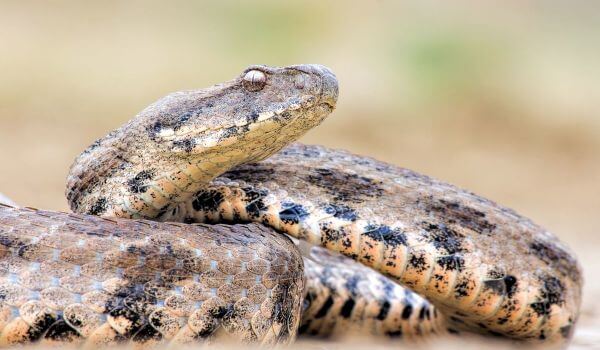
Photo: Gyurza from the Red Book
Gyurza has considerable dimensions, is very fast, lightning fast, dangerous and poisonous, so many animals avoid communicating with her, especially attacking a reptile, but there are those who like gyurza. Among them, the monitor lizard is the most dangerous enemy for the gyurza in natural conditions.
The thing is that the strongest and toxic poison of the gyurza has absolutely no effect on it, the monitor lizard is not susceptible to it, therefore it is not afraid to attack levant viper. Sometimes a wolf, reed cat, fox, jackal can attack a gyurza. Of course, these mammals risk their lives, because they do not have an antidote. Animals usually attack during difficult, hungry periods, when they cannot find other prey.
In addition to terrestrial animals, some birds also hunt gyurza, attacking from above, right on the fly. Birds such as short-toed eagles and prairie buzzards usually do this. Young growth, which is not yet a year old, often suffers from the attack of other reptiles (sandy ef, Central Asian cobra). Inexperienced snakes are also overcome by the desert monitor lizard.
They can also be attacked by such birds as the long-legged buzzard and the black kite. If young individuals of the gyurza notice any threat, they try to immediately hide, run away. When escape is not possible, the reptiles begin to attack, making swift attacks, more than a meter long. Often this helps to escape, because Levantine vipers are not only poisonous, but very strong and powerful.
Population and species status
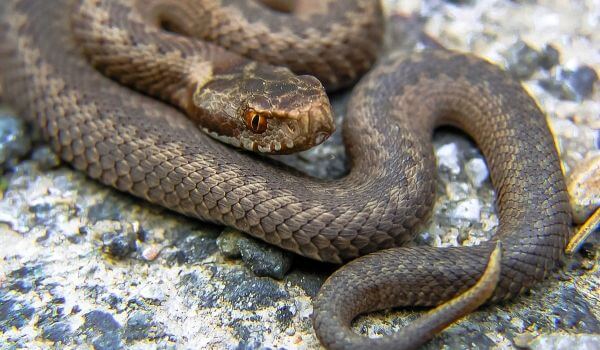
Photo: Gyurza in Russia
The habitat of Levant vipers is quite wide and diverse. At the moment, various organizations involved in the protection of animals and nature at the international level claim that nothing threatens the number of gyurz, there are a lot of these snakes in almost all territories where they have a permanent residence permit. This statement is consistent with the numerical calculations made by scientists.
They show that in the usual place of permanent deployment of gyurz, there are four individuals per hectare, and in the hot summer near various water spaces, up to twenty of them per hectare gather. As a result of these data and other studies, there are no concerns about the size of the gyurza population, there are no threats of extinction, but this is not the case everywhere.
In some countries, the gyurza population is very small. This happened as a result of the development of rapid human agricultural activity and the mass capture of snakes. It is no secret that gyurza poison is used in pharmaceuticals, making some medicines from it that help with rheumatism, radiculitis, hemophilia.
Ill-considered human actions led to the fact that gyurza is listed in the Red Book in Russia and Kazakhstan. It’s good that such a small state of the population is local, and in other regions the gyurza feels great and is not subject to the threat of destruction.
Protection of the gyurza
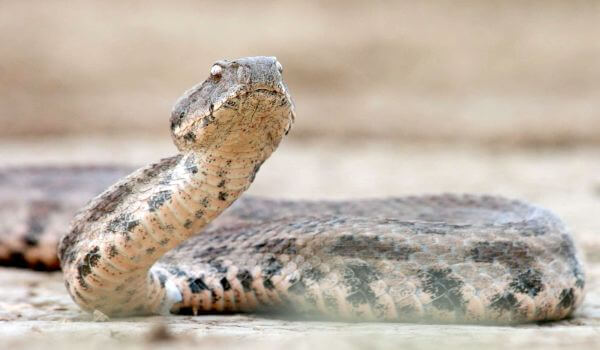
Photo: Gyurza from the Red Book
As mentioned earlier, things are not going well with the population of Levan vipers everywhere, in some areas these amazing reptiles are becoming less and less. In our country, gyurza is in the Red Book. On the territory of Russia, this type of snake lives in Dagestan, namely, in its southeastern part. It is safe to say that we have this is the most dangerous of the poisonous snakes. Gyurza, living in Dagestan, is called Transcaucasian, its distinguishing features are the presence of numerous shields on the abdomen and the absence (very small amount) of dark specks on it.
The population of the Transcaucasian gyurza is very small. Calculations made several years ago showed that there were no more than 1000 individuals left of these snakes. This situation has developed due to human destruction of the reptile’s permanent habitat: plowing land, grazing on mountain slopes and lowlands, interfering with the system of mountain rivers for irrigation.
Besides all this, catching snakes has never been was regulated, therefore, about 100 reptiles were caught annually for pharmaceutical purposes, the size of which was more than 70 cm, and these are the most reproductive individuals. It is worth noting that not only in our country, but also in Kazakhstan, there are very few Levantine vipers left, therefore this snake is also in the Red Book there.
In the end, I would like to add that the size of the gyurza, its power, danger , which it generates, the strongest poison and insidious disposition make one shudder at the thought of this formidable reptile. But do not forget that it brings considerable benefits to people, destroying hordes of rodent pests in cultivated fields. In addition, oddly enough, gyurza poison has valuable healing properties.

